跨文化商务交际第一章
跨文化商务交际(窦卫霖)
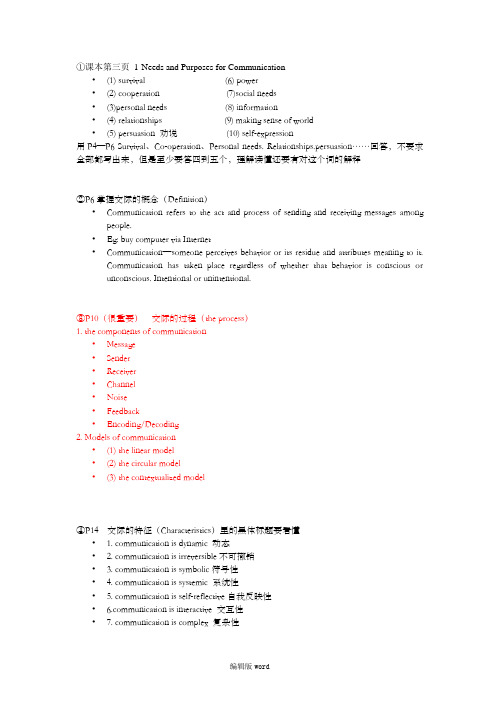
①课本第三页1-Needs and Purposes for Communication•(1) survival (6) power•(2) cooperation (7)social needs•(3)personal needs (8) information•(4) relationships (9) making sense of world•(5) persuasion 劝说(10) self-expression用P4—P6 Survival、Co-operation、Personal needs. Relationships.persuasion……回答,不要求全部都写出来,但是至少要答四到五个,理解读懂还要有对这个词的解释②P6掌握交际的概念(Definition)•Communication refers to the act and process of sending and receiving messages among people.•Eg: buy computer via Internet•Communication—someone perceives behavior or its residue and attributes meaning to it.Communication has taken place regardless of whether that behavior is conscious or unconscious. Intentional or unintentional.③P10(很重要)交际的过程(the process)1. the components of communication•Message•Sender•Receiver•Channel•Noise•Feedback•Encoding/Decoding2. Models of communication•(1) the linear model•(2) the circular model•(3) the contextualized model④P14 交际的特征(Characteristics)里的黑体标题要看懂• 1. communication is dynamic 动态• 2. communication is irreversible不可撤销• 3. communication is symbolic符号性• 4. communication is systemic 系统性• 5. communication is self-reflective自我反映性• munication is interactive 交互性•7. communication is complex 复杂性⑤P22里的最后一段中影响跨文化交际的主要三个因素Language barriers,different values,different cultural patterns of behavior⑥ICC与ICBC的概念1. intercultural communication (ICC)•--interpersonal communication between members of different cultures.2. intercultural business communication (ICBC)•--communication within and between businesses that involve people from more than one culture⑦P31课后练习中的Discussion Questions的前三个问题⑧P41 关于文化的概念在这页的第五段•Culture is the total accumulation(积累)of beliefs, customs, values, behaviors, institutions (习俗)and communication patterns(样式)that are shared, learned and passed down through the generations in an identifiable group of people.⑨P42 文化的特点还要解释四个到五个• 1. culture is not innate; it is learned (e.g. sneezing)• 2. culture is transmitted from generation to generation• 3. culture is selective• 4. the facets of culture are interrelated (e.g. women’s movement)• 5. culture is ethnocentric• 6. culture is subject to change⑩P46价值观的概念(definition of value)•One’s principles or standards, one’s judgment of what is valuable or important in life • A broad tendency to prefer certain states of affairs over others. (Hofstede P46)• A conception, explicit or implicit, distinctive of an individual or characteristic of a group, of the desirable which influences the selection from available modes, means, and ends of action.⑾P45(重点)values from the core of culture• 1.values form the core of culture• 2. values are the deepest manifestations of culture and most difficult to understand by an outsider. (symbols-heroes-rituals-values, by Hofstede)⑿P48 价值观的分类• 1.universal values (e.g., happy life)• 2.cultural-specific values (e.g.. modesty for Chinese culture)• 3. peculiar expression or deviations of individuals within cultures (subjective culture)⒀P49 价值观是怎样形成的?how to get one’s value?• 1. from one’s family• 2.from school education teachers• 3. from one’s peers• 4. from society at large⒁P59(很重要)hofstede-Bond's Value Dimensions•Individualism vs. Collectivism (P.61)•Power Distance•Uncertainty Avoidance•Masculinity vs. Femininity回答这个题目时要说这个理论是谁写的,叫什么名字,理论是什么(从P60-64四个角度回答)还要解释,还要给例子,比如P62的图表。
《跨文化商务交际》课程学习大纲课程名称:跨文化商务交际课程英文
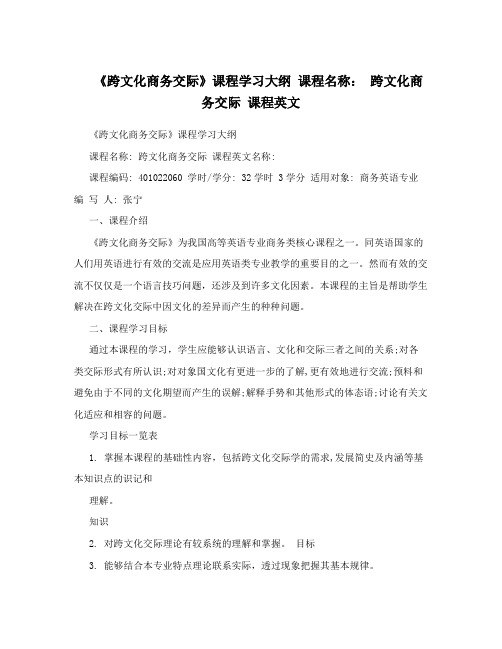
《跨文化商务交际》课程学习大纲课程名称:跨文化商务交际课程英文《跨文化商务交际》课程学习大纲课程名称: 跨文化商务交际课程英文名称:课程编码: 401022060 学时/学分: 32学时 3学分适用对象: 商务英语专业编写人: 张宁一、课程介绍《跨文化商务交际》为我国高等英语专业商务类核心课程之一。
同英语国家的人们用英语进行有效的交流是应用英语类专业教学的重要目的之一。
然而有效的交流不仅仅是一个语言技巧问题,还涉及到许多文化因素。
本课程的主旨是帮助学生解决在跨文化交际中因文化的差异而产生的种种问题。
二、课程学习目标通过本课程的学习,学生应能够认识语言、文化和交际三者之间的关系;对各类交际形式有所认识;对对象国文化有更进一步的了解,更有效地进行交流;预料和避免由于不同的文化期望而产生的误解;解释手势和其他形式的体态语;讨论有关文化适应和相容的问题。
学习目标一览表1. 掌握本课程的基础性内容,包括跨文化交际学的需求,发展简史及内涵等基本知识点的识记和理解。
知识2. 对跨文化交际理论有较系统的理解和掌握。
目标3. 能够结合本专业特点理论联系实际,透过现象把握其基本规律。
1. 通晓跨文化交流的本质、基本理论和技巧。
2. 了解文化差异产生的过程。
能力目标 3. 掌握基本的沟通方法和策略。
4. 提高英语语言运用能力和跨文化交际能力1. 培养科学、严谨的学习态度、执着探索、创新改革的科学精神。
文化素质2. 培养自身的国际视野、创新意识、跨文化交际和人际交往意识。
目标三、课程教学内容《跨文化商务交际》课程的教学内容共分为八个模块,每个模块由基础性内容、提高性内容、拓展性内容三部分构成,基础性内容是必须掌握的内容,提高性内容是在基础性内容的基础上对基本问题的探讨和梳理,拓展性内容是对所学知识的延伸性学习,是课程内容的前瞻性分析和理论延展。
第1至4章以跨文化交际学的基本理论为框架,阐述阐述交际、文化、跨文化交际等基本概念、交际与文化的关系;介绍文化差异在言语和非言语交际方面的表现;不同的文化价值观的理论划分,以及在文化层面上分析了人们在跨文化商务交际中存在的众多价值观念差异。
备课教案第一章跨文化交际

备课教案第一章跨文化交际一、引言跨文化交际是指不同文化下的个体之间进行沟通和交流的过程。
在全球化的下,跨文化交际的重要性越来越被人们所重视。
在教育领域,培养学生的跨文化交际能力已成为一项重要任务。
本教案的第一章将介绍跨文化交际的概念、原则和意义,并提供一些教学方法和策略。
二、跨文化交际的概念跨文化交际是指在不同文化下,个体之间进行交流和互动的过程。
跨文化交际涉及到语言、文化、社会习俗和价值观等方面的差异。
在跨文化交际中,个体需要理解和尊重对方的文化差异,同时要注意自己在交际中所表现出来的行为和态度。
三、跨文化交际的原则1.尊重差异:在跨文化交际中,应该尊重对方的文化差异,包括语言、礼仪、思维方式等方面的差异。
不应该对对方的文化进行歧视或偏见。
2.适应变化:在跨文化交际中,个体需要适应不同的文化环境和情境。
需要灵活地调整自己的行为和态度,以便更好地与对方进行交流。
3.建立共同语言:虽然语言可能是跨文化交际中的一个障碍,但个体可以通过学习对方的语言,或者使用一种中性的语言来建立共同的语言,从而更好地进行交流。
4.接纳多样性:在跨文化交际中,个体需要接纳不同的文化观念和价值观。
要意识到每个文化都有其独特的优点和特点,不应该将自己的文化观念强加于他人。
四、跨文化交际的意义跨文化交际具有重要的意义,它可以促进不同文化之间的交流和理解,有助于消除文化冲突和误解。
在教育领域,培养学生的跨文化交际能力可以帮助他们更好地适应多元文化的社会,并且能够为未来的国际交流和合作提供基础。
五、跨文化交际的教学方法和策略1.多元文化教育:在教学中注重引入多元文化的内容和案例,让学生了解不同文化的差异和特点。
2.语言对比学习:通过对比不同文化下的语言差异,帮助学生理解文化之间的差异,从而更好地进行跨文化交际。
3.资源共享:鼓励学生分享自己的文化和经验,这样可以促进学生之间的互相了解和交流。
4.情景模拟:通过模拟真实的跨文化交际情景,让学生在实践中学习如何应对文化差异和问题。
跨文化商务交际导论
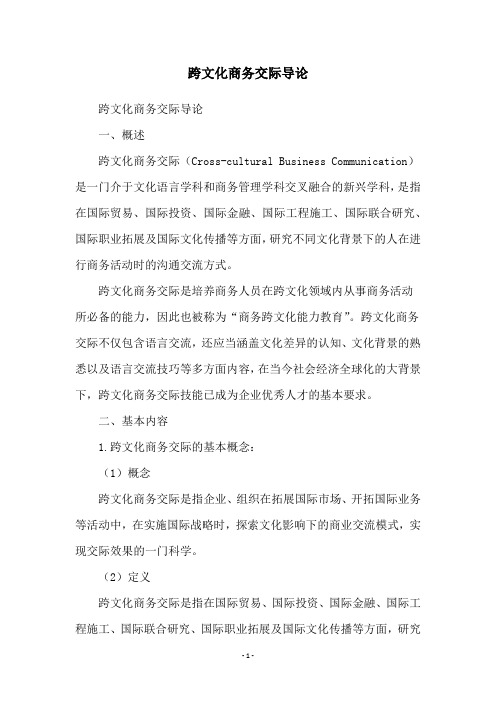
跨文化商务交际导论跨文化商务交际导论一、概述跨文化商务交际(Cross-cultural Business Communication)是一门介于文化语言学科和商务管理学科交叉融合的新兴学科,是指在国际贸易、国际投资、国际金融、国际工程施工、国际联合研究、国际职业拓展及国际文化传播等方面,研究不同文化背景下的人在进行商务活动时的沟通交流方式。
跨文化商务交际是培养商务人员在跨文化领域内从事商务活动所必备的能力,因此也被称为“商务跨文化能力教育”。
跨文化商务交际不仅包含语言交流,还应当涵盖文化差异的认知、文化背景的熟悉以及语言交流技巧等多方面内容,在当今社会经济全球化的大背景下,跨文化商务交际技能已成为企业优秀人才的基本要求。
二、基本内容1.跨文化商务交际的基本概念:(1)概念跨文化商务交际是指企业、组织在拓展国际市场、开拓国际业务等活动中,在实施国际战略时,探索文化影响下的商业交流模式,实现交际效果的一门科学。
(2)定义跨文化商务交际是指在国际贸易、国际投资、国际金融、国际工程施工、国际联合研究、国际职业拓展及国际文化传播等方面,研究不同文化背景的人在进行商务活动时的沟通交流方式的学科。
2.跨文化商务交际的基本内容(1)文化差异文化差异是国际商务活动中,不同民族、不同团体之间具有明显不同的文化特性和价值取向的状态,是影响商务沟通的重要因素。
(2)文化背景文化背景指每一文化有其独特的文化特征,可以帮助人们理解彼此的做法和思维方式,为了有效地实施跨文化商务交际,必须有效地探索和了解不同文化的基本特点。
(3)语言交流语言交流是指双方运用不同语言在跨文化商务实践中实现有效沟通的过程,需要根据语言和文字之间的关系洞察语言的双重性、多样性以及有效表达语言信息的方式。
(4)沟通技巧沟通技巧包括言语表达技巧、语言表达技巧、文化表达技巧等,是跨文化商务活动中的重要组成部分,也是提高跨文化商务技能的关键因素。
三、结束语跨文化商务交际是一门介于文化语言学科和商务管理学科交叉融合的新兴学科,它涵盖了文化差异的认知、文化背景的熟悉以及语言交流技巧等多方面内容。
跨文化商务交际

跨文化商务交际Intercultural Business Communication窦卫霖编著前言一个企业的成功,不仅取决于它的生产能力,而且取决于它的文化能力;在国际商务活动中,还取决于它的跨文化交际能力。
经济全球化的趋势、国际商务活动的日益频繁,越来越显示出对多元文化理解的必要性和跨文化交际能力的重要性。
跨文化意识意味着直接的经济效益。
如果一个企业想让自己的产品在国际市场上占有一席之地,一个跨国公司想在其他国家或地区取得经济效益,那么就不仅需要具有高超的经济、技术和管理水平,而且需要深刻了解对象国的文化。
正因为如此,世界上许多大公司在国际商务活动中都十分重视跨文化交流的研究和培训,许多经贸类大学都把跨文化商务交际课程作为必修课。
21世纪的中国是走向国际广泛合作的中国。
自中国加入WTO以来,国际著名跨国集团公司、金融机构、工商企业都纷纷来中国设立分支机构、分公司,招聘大量的中国雇员。
同时,中国工商贸易企业也在不断加大出口力度,在国内外建立跨国公司,雇佣来自不同文化背景的雇员。
文化合作已成为当代中国商务合作的重要内容。
文化交融现象激励商务英语教学加速培养复合型的经贸外语人才,促进他们不仅要掌握跨学科的专业知识,而且要具备跨文化交往的技能。
在商务英语教学中把跨文化交际能力的培养放在十分突出的位置已经成为普遍的共识。
那么在培养复合型人才的战略中,如何培养和提高跨文化交际的能力呢?在我国,经贸学校一般都开设有关跨文化交际的课程,跨文化交际专著、论文也不断涌现。
但总体来说,跨文化商务交际在我国商界和相关专业的教学中还处于比较薄弱的初级阶段,与发达国家相比还有较大的差距,尤其是如何把商务活动实践与跨文化交际理论结合起来,如何把国际商务文化与中国本土文化结合起来,还是一个难题。
这方面的书籍也特别少,适合商英类专业学生使用的教材更少。
有鉴于此,作者根据多年跨文化交际和跨文化商务交际教学的经验,参考了大量国内外的最新相关材料,编写了这本《跨文化商务交流》教材,希望成为大学英语相关专业学生以及商务人员进修提高的可用教材。
文化的定义跨商务文化交际

商务环境中的沟通障碍与解决方式
误解与偏见
由于文化背景的差异,可能导致 对对方行为的误解和偏见。
缺乏共同语言
不同文化背景的人可能使用不同 的语言或术语,导致沟通困难。
沟通风格不同
不同文化背景的人Hale Waihona Puke 能有不同的 沟通风格,如直接或委婉。
适应沟通风格
根据对方的文化背景调整自己的 沟通方式。
跨商务文化交际是指在不同 文化背景下的商务交流和合 作。成功的跨商务文化交际 需要具备文化意识和跨文化 沟通能力,以促进相互理解 和合作。
文化差异对商务交流和合作 产生重要影响,包括语言沟 通、谈判技巧、决策方式等 方面。因此,在跨商务文化 交际中,需要充分了解和尊 重文化差异,以避免误解和 冲突。
文化的重要性
01
02
03
促进社会和谐
文化是社会凝聚力的源泉, 它有助于形成共同的社会 规范和价值观,促进社会 和谐与稳定。
塑造个体行为
文化对个体的思想、行为 和价值观产生深远影响, 塑造个体在社会中的角色 和行为方式。
推动经济发展
文化作为一种产业,能够 创造经济价值,推动经济 发展和社会进步。
文化的影响因素
非语言信息差异
肢体语言、面部表情等非语言信息在不同文化中 可能有不同的含义,可能导致沟通障碍。
语言障碍
语言是跨文化交际的核心媒介,但不同语言的语 法、语义、表达方式等方面存在差异,可能导致 信息传递的误解。
应对策略
尊重文化差异,增强文化敏感性和包容性;学习 并掌握目标文化的语言和非语言信息;培养有效 的沟通技巧,如倾听、表达和反馈;利用专业机 构和人士进行跨文化培训和指导。
跨文化交际 知识点整理
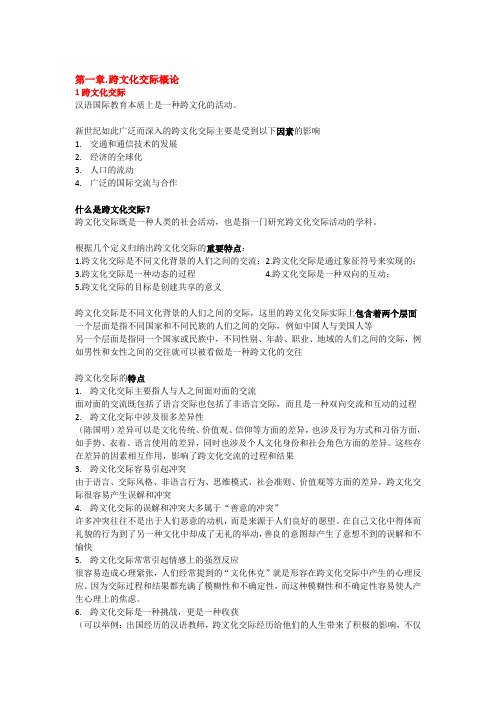
第一章.跨文化交际概论1跨文化交际汉语国际教育本质上是一种跨文化的活动。
新世纪如此广泛而深入的跨文化交际主要是受到以下因素的影响1.交通和通信技术的发展2.经济的全球化3.人口的流动4.广泛的国际交流与合作什么是跨文化交际?跨文化交际既是一种人类的社会活动,也是指一门研究跨文化交际活动的学科。
根据几个定义归纳出跨文化交际的重要特点:1.跨文化交际是不同文化背景的人们之间的交流;2.跨文化交际是通过象征符号来实现的;3.跨文化交际是一种动态的过程4.跨文化交际是一种双向的互动;5.跨文化交际的目标是创建共享的意义跨文化交际是不同文化背景的人们之间的交际,这里的跨文化交际实际上包含着两个层面一个层面是指不同国家和不同民族的人们之间的交际,例如中国人与美国人等另一个层面是指同一个国家或民族中,不同性别、年龄、职业、地域的人们之间的交际,例如男性和女性之间的交往就可以被看做是一种跨文化的交往跨文化交际的特点1.跨文化交际主要指人与人之间面对面的交流面对面的交流既包括了语言交际也包括了非语言交际,而且是一种双向交流和互动的过程2.跨文化交际中涉及很多差异性(陈国明)差异可以是文化传统、价值观、信仰等方面的差异,也涉及行为方式和习俗方面,如手势、衣着、语言使用的差异,同时也涉及个人文化身份和社会角色方面的差异。
这些存在差异的因素相互作用,影响了跨文化交流的过程和结果3.跨文化交际容易引起冲突由于语言、交际风格、非语言行为、思维模式、社会准则、价值观等方面的差异,跨文化交际很容易产生误解和冲突4.跨文化交际的误解和冲突大多属于“善意的冲突”许多冲突往往不是出于人们恶意的动机,而是来源于人们良好的愿望。
在自己文化中得体而礼貌的行为到了另一种文化中却成了无礼的举动,善良的意图却产生了意想不到的误解和不愉快5.跨文化交际常常引起情感上的强烈反应很容易造成心理紧张,人们经常提到的“文化休克”就是形容在跨文化交际中产生的心理反应。
商务跨文化交际.doc

课题:商务场合中的跨文化交际前言:现今中国已经融入世界经济全球化的大潮。
随着外商在华投资与日俱增和我国本土企业对外经贸联系日益加强,不同层次的跨文化商务活动越发频繁。
人才市场对既懂国际商务规则又能用英语与不同文化背景的人们进行涉外活动的商务英语人才的需求趋势不断上升。
作为对外贸易,突出跨文化交际能力的培养显得尤为重要。
(正文):一、跨文化的基本概念二、商务场合中的跨文化常出现问题及其原因<一>价值观的迥异<二>思维模式的不同<三>环境的影响<四>民族中心主义三、商务场合的跨文化策略<一>多多接受不同文化的熏陶,多了解不同的价值观<二>比较目标语言和母语文化的异同,提高对文化差异的敏感性。
打破固有的思维模式。
<三>模拟真实情景,强化跨文化交际的意识<四>易位思考,改正民族中心主义弊端。
结束言:在商务场合中,如果能够尊重双方的文化差异,灵活使用跨文化交际策略,必将在很大程度上促进商务合作的成功进行。
商务活动无论是建立、合作、后续的各个环节一方都要熟悉对方文化,增强对文化差异的敏感性,减少由于文化差异造成的不稳定因素,这样才能增加与对方行为的协和性,从而使商务活动变得更为顺利,增加达成合作的机会。
培养跨文化交际意识对商务活动而言是重要的,有了跨文化交际意识,不仅有助于克服文化障碍,发现导致彼此误解或对立的原因,对症下药实现有效的沟通。
商务场合中的跨文化交际【摘要】全球经济一体化使现代化商场上出现越来越多的跨文化交际活动。
不同语言和不同文化背景的商务人员为了经济目的而走到一起,相互交往,进行各种经济活动。
这种交际活动既涉及不同的文化或相同文化的不同亚文化,又涉及交际各方不同的经济背景,交际过程往往会因种种因素而中断甚至失败。
本文分析了导致商务交往中跨文化交际失败的主要原因,探讨关于商务交际中断或失败的各种原因及其解决办法。
学堂课程在线“一带一路”沿线国家跨文化商务交际(大外)课后作业答案

“一带一路”沿线国家跨文化商务交际(大外)第一章课后作业判断题(1分)Thailand is known as “Land of Smiles”. ( )正确答案√判断题(1分)Thailand also features its abundant rivers. ( )正确答案√判断题(1分)The capital city of Thailand is Phuket. ( )正确答案×判断题(1分)Thailand’s traditional major markets have been ASEAN, the United States, and EU. ( )正确答案√判断题(1分)Thai people respect for elders thus senior colleagues are obeyed and respected in business environment. ( )正确答案√判断题(1分)Thai people prefer to do business with people they know. ( )正确答案√判断题(1分)Thiland is the only country in Southeast Asia who maintains its sovereignty along history. ( )正确答案√判断题(1分)Thai people regard a person’s head as a sacred part, whh should not be touched by anyone.( )正确答案√判断题(1分)You should not go into a Thai business partner’s house with your shoes on. ( )正确答案√判断题(1分)Informal conversations before and after business meetings are important social part in Thailand. ( )正确答案√判断题(1分)You should arrange business meetings with Thai people early in the morning. ( )正确答案×判断题(1分)It’s important to wait to be seated by you Thai host when attending business dinner in Thailand. ( )正确答案√第二章课后作业判断题(1分)Singapore is one of the smallest and most densely populated countries in the world. ( )正确答案√判断题(1分)Singapore is a country with plenty of resources and of vastly different ethnic groups. ( ) 正确答案×判断题(1分)Singaporeans attach importance on competitiveness and a strong work ethics. ( )正确答案√判断题(1分)An important value in Singaporean culture is to preserve and maintain “face”. ( )正确答案√判断题(1分)It is likely that the cultural background of your host will influence your dining experience in Singapore. ( )正确答案√判断题(1分)Men are suggested to wear long-sleeved shirts and ties in SingaporeanBusiness workplace. ( )正确答案√判断题(1分)The communication styles of Singaporeans are direct and explicit. ( )正确答案×判断题(1分)You’d better put the business card you have received in a professional case or place it on the table beside you instantly in Singapore business setting. ( )正确答案×判断题(1分)You should not be late for a business appointment in Singapore, even though Singaporeans tend to arrive late for social events. ( )正确答案√判断题(1分)Giving a gift is often regarded as a bribery in Singapore, so you have to be very cautious when doing it.正确答案√判断题(1分)When it is difficult for you to figure out all the complicated introductions in Singapore’s greeting culture, you’d better wait and see what the other person will do and follow suit. ( ) 正确答案√判断题(1分)The characteristic of Singapore’s negotiation process is fast. ( )正确答案×第三章课后作业判断题(1分)Malaysia’s official language is Malay. ( )正确答案√判断题(1分)Malaysia doesn’t have many geographical features. ( )正确答案×判断题(1分)Malaysia is a country rich in cultural diversities. ( )正确答案√判断题(1分)Malaysians expect fancy gifts from their business partners. ( )正确答案×判断题(1分)Malaysia is known as an important knot in the sea route of Silk Road. ( )正确答案√判断题(1分)Ina business setting, Malaysians prefer to ask private questions to get to know their business partners. ( )正确答案√判断题(1分)You should avoid wear yellow clothes when conducting business inMalaysia. ( )正确答案√判断题(1分)You don’t need an introduction letter when dealing business withMalaysians, because they are very approachable. ( )正确答案×判断题(1分)Business meetings and negotiations tend to be long in Malaysia due to their religious belief in fatalism. ( )正确答案√判断题(1分)You should address your Malaysian business partners according to proper titles. ( )正确答案√判断题(1分)You should avoid being too direct with your Malaysian business partners. ( )判断题(1分)Malaysia is a member country of ASEAN. ( )正确答案√第四章课后作业判断题(1分)Kazakhstan is the world’s biggest landlocked country. ( )正确答案√判断题(1分)Kazakhstan is traditionally abundant in metals, coal, and livestock products. ( )正确答案×判断题(1分)Kazakhstan has one of the world’s highest literacy rates. ( )正确答案√判断题(1分)The official language in Kazakhstan is Kazakh. ( )正确答案×判断题(1分)Kazakhstan is known as a highly energy-intensive country. ( )正确答案√判断题(1分)Family is the core value of Kazakhstan society. ( )正确答案√判断题(1分)You can also shake hands with female Kazakh business partners in working environment in Kazakhstan. ( )正确答案×判断题(1分)Food in Kazakhstan may have symbolic meangs, such as goat. ( )判断题(1分)Shoes are a very important part in Kazakhstan business dress code. ( )正确答案√判断题(1分)Kazakhs can act very aggressive while making negotiations in business meetings. ( )正确答案√判断题(1分)You should avoid arrange your meeting time with Kazakh business partners during their prayer time. ( )正确答案√判断题(1分)You should print your business card in Kazakh since Kazakh is the official language. ( )正确答案×第五章课后作业填空题(1分)The Saudi Arabia is located in____正确答案:[ "Arabian Peninsula" ]填空题(1分)The capital city of Saudi Arabia is____正确答案:[ "Riyadh" ]填空题(1分)The official currency of Saudi Arabia is ____正确答案:[ "Saudi riyal" ]填空题(1分)The official language of Saudi Arabia is____正确答案:[ "Arabic" ]填空题(1分)The religion of Saudi Arabia is____正确答案:[ "Islam" ]填空题(1分)Saudi Arabia has____natural gas reserves in the world.正确答案:[ "the sixth largest" ]判断题(1分)When dining with Saudi business partners, lamb would be a proper choice to serve as the common meat. ( )正确答案√判断题(1分)There is no need for women to wear a hijab at all times to cover their hair. ( )正确答案×判断题(1分)It would be better for you to learn a sentence or two of Arabic; it will be a sign of respect for the Arab culture. ( )正确答案√判断题(1分)According to Islam, the left hand is considered unclean and reserved for personal hygiene. Arabs traditionally use the right hand for all public functions- including shaking hands, eating, drinking and passing objects to another person. ( )正确答案√判断题(1分)Timing is not an issue, so Saudis are generally unpunctual compared to Western standards. However, you must be on time.正确答案√判断题(1分)Extravagant or expensive gifts could be given to Saudis, especially in front of others. ( )正确答案×第六章课后作业单选题(1分)UAE is a federation consists of ____ states.A 5B 6C 7D 8正确答案C单选题(1分)What are the working hours in UAE? ____A Office hours of Western style has been highly appreciated in the UAE.B Running all day long with a short break for high tea.C Some state-owned companies are only closed on Fridays.D There are two days off a week in UAE.正确答案A单选题(1分)What should you pay attention to when making appointments with Emiratis? ____A Appointments should generally be set no more than a shole week in advance.B Appointments should be reassured again one or two days before the actual meeting.C It is always suggested to be relaxed and come prepared a better appearance for appointment.D The participants of the appointment should be well taken care of.正确答案B单选题(1分)What is the Official currency in UAE? ____A EuroB CCYC SRD AED正确答案D单选题(1分)What is the attitude of Emiratis toward time? ____A They totally don’t care.B They regard relationships as the extraordinary statue.C Not flexible.D They maintain the rigid punctuality in business.正确答案B单选题(1分)How to make Business negotiations in UAE? ____A Business negotiations require mutual respect.B Just set a clear goal and strive for it all the time.C Negotiators should be friendly and rigorous.D The Emiratis cannot tolerance negative expressions.正确答案A判断题(1分)Both men and women should wear business suits that are well-fitting and stylish. ( )正确答案√判断题(1分)It is rare to see women working in a business environment, since most stay home in the traditional role taking care of the house and family. ( )正确答案×判断题(1分)According to Islam, the left hand is considered unclean and reserved for personal hygiene. Emiratis traditionally use the right hand for all public functions — including shaking hands, eating, drinking and passing objects to another person. ( )正确答案√判断题(1分)Schedules and punctuality are prior to relationships. ( )正确答案×判断题(1分)Islam is also written into civil and commercial law and affects almost every aspect of society, from personal interactions to the wider culture. ( )正确答案√判断题(1分)Oil exports, the main factor, has made the UAE becoming one of the richest countries in the Muslim world. ( )正确答案√第七章课后作业判断题(1分)India is the second-largest country in South Asia. ( )正确答案×判断题(1分)India is a Federal Union where almost all of its states carry different languages, different cultural identities. ( )正确答案√判断题(1分)The Indus Valley Empire is the last and the strongest Islamic empire in India. ( )正确答案×判断题(1分)Cows are considered sacred animals by Hindus. ( )正确答案√判断题(1分)Indian currency is Indian Rupee. ( )正确答案√判断题(1分)The hierarchical system in Indian companies is influence by traditional caste system. ( )正确答案√判断题(1分)Indians believe in fatalism so they tend to have longer business negotiations to let things come about naturally. ( )正确答案√判断题(1分)Indians are fun-loving people so when conducting business with Indians, you should act lively and humorously. ( )正确答案×判断题(1分)You can always invite your Indian business partners to a pub after business meetings. ( ) 正确答案×判断题(1分)You should avoid too passionate ways of greetings with Indians due to their religious belief. ( )正确答案√判断题(1分)You can avoid the CSR policy in India, because you are a foreign business partner. ( )正确答案×判断题(1分)40 percent fluctuation in terms of negotiation price is normal when conducting business in India. ( )正确答案√第八章课后作业判断题(1分)Russia is the largest country in the world, spanning 11 time zones and bordering 14 sovereign countries. ( )正确答案√判断题(1分)Russian culture has mainly European traditions. ( )正确答案×判断题(1分)People tend to think of “deals” in terms of equalization of interests. ( )正确答案√判断题(1分)In business, Russians are direct and don’t shy away from confrontation. ( )正确答案√判断题(1分)In a Russian business meal, toasts are made frequently throughout a meal.正确答案√判断题(1分)Businessmen in Russia usually wear light-color well-tailored suits along with the expensive shoes. ( )正确答案×判断题(1分)Russians love to engage in small talk, so they tend to hold on the phone when an agreement is made. ( )正确答案×判断题(1分)Successful businesses in Russia adapt quickly to changing circumstances.Schedules change all the time due to weather, long distances, traffic and general bad timekeeping. ( ) 正确答案√判断题(1分)People shake hands and give things across a threshold a house or room. ( )正确答案×判断题(1分)A good topic of conversation is usually the changes taking place in Russia. ( )正确答案√判断题(1分)Written word is considered more trustworthy than Verbal communication. ( )正确答案×判断题(1分)Business card in Russian is printed in English on one side and Russian on the other. ( )正确答案√第九章课后作业判断题(1分)Bigos is a very popular traditional dish in Poland. ( )正确答案√判断题(1分)The currency in Poland is Zloty. ( )正确答案√判断题(1分)Polish citizens doesn’t have a strong sense of community. ( )正确答案×判断题(1分)Asa family-centred society, Poles rely on establishing and maintaining close interpersonal relationships. ( )正确答案×判断题(1分)The most common toast is to your career. ( )正确答案×判断题(1分)Ina business meal, the most honored position is at the head of the table, with the most important guest seated immediately to the right of the host. ( )正确答案√判断题(1分)In order to give a good first impression in business community, Poles tend to wear formal clothing. ( )正确答案√判断题(1分)8.Most Poles speak only Polish in business.正确答案×判断题(1分)Important business issues must be discussed in person and frequent visits and phone calls are essential to establish the business relationship and basis for a written agreement. ( )正确答案√判断题(1分)You can use your Polish partners’ first names after two or three meetings. ( )正确答案√判断题(1分)Everyone has to be punctual in Polish business, even the people in higher positions. ( )正确答案×判断题(1分)Gifts are given at the first business meeting or upon the conclusion of any business arrangement. ( )正确答案√第十章课后作业单选题(1分)What have been the main exports? ()A Agricultural products and military equipment.B Chemical productsC Motor vehiclesD Some fruits.正确答案A单选题(1分)What are the South Africans’ attitude toward time?()A black South Africans do things a little quicker.B White South Africans do things a little slower.C They have a more formal view of time.D For white and black people living in South Africa, the concept of time and attitudes toward it vary.正确答案D单选题(1分)What we can do to facilitate the business negotiation with South Africans?()A Talking about the negotiation immediately.B We better use the phone meeting.C Building mutual trustD Learning a language other than English.正确答案C单选题(1分)What is the formal business dress code in South Africa? ()A People can wear a pair of shorts if the weather is very hot.B Women can wear a formal tight suit.C Men can wear a suit.D People can wear traditional African garment.正确答案C判断题(1分)South Africa is located at the southern tip of the continent of Africa.正确答案√判断题(1分)Language in South Africa is English and Afrikaans.正确答案√判断题(1分)Business banquets are not meant to be negotiated, but rather to talk business in a more casual setting. ( )正确答案√判断题(1分)During Ramadan, you can invite South Africans to eat together in the evening.正确答案×判断题(1分)Avoid wearing clothes that are too tight or exposed. ( )正确答案√判断题(1分)When invited to a South African’s home, it is good practice to takea gift of flowers, chocolates. ( )正确答案√判断题(1分)There is no need to worry about the language of doing business, since most South Africans involved in international business speak English.正确答案√判断题(1分)Since South Africa’s approach to deadlines is generally flexible, so there is no need to mention strict deadlines in contracts.正确答案×。
跨文化交际在国际商务中的重要性

跨文化交际在国际商务中的重要性第一章: 引言随着全球化的深入发展,国际贸易越来越繁荣。
与此同时,跨文化交际在国际商务中的重要性日益凸显。
在国际商务中,由于涉及到不同的文化背景和语言环境,跨文化交际扮演着关键的角色。
本文将介绍跨文化交际的相关概念、特点以及在国际商务中的应用。
第二章: 跨文化交际的概念和特点2.1 跨文化交际的概念跨文化交际是指在不同的文化背景和语言环境下进行的交流活动。
在跨文化交际中,不同的文化背景和语言环境会对双方的思维方式、信息处理方式、语言表达方式等方面产生影响,从而会影响跨文化交际的成功率。
2.2 跨文化交际的特点跨文化交际具有以下几个特点:1)在跨文化交际中,不同的文化背景和语言环境会对信息的传递和理解产生影响,从而容易产生误解和文化冲突。
2)跨文化交际中的成功不仅取决于语言水平的高低,还取决于双方的文化素质和文化适应能力。
3)跨文化交际需要双方具备开放的心态和较高的文化自觉性,以便更好地理解和尊重双方的文化差异。
第三章:跨文化交际在国际商务中的重要性3.1 提升商务合作的成功率在国际商务中,跨文化交际能够提升商务合作的成功率。
由于涉及到不同的文化背景和语言环境,如果没有跨文化交际的支持,容易产生误解和文化冲突,从而影响商务合作的开展。
因此,在跨文化交际的支持下,双方可以更好地理解对方的需求和要求,从而提升商务合作的成功率。
3.2 减少商务风险在国际商务中,跨文化交际能够减少商务风险。
由于不同的文化背景和语言环境的影响,容易产生误解和文化冲突,从而导致商务风险的发生。
通过跨文化交际,双方可以更好地理解对方的需求和要求,从而减少商务风险的发生。
3.3 增强国际竞争力在国际商务中,跨文化交际能够增强企业的国际竞争力。
由于涉及到不同的文化背景和语言环境,如果没有跨文化交际的支持,容易导致企业在国际市场上丧失竞争力。
因此,在跨文化交际的支持下,企业可以更好地理解和适应不同的文化背景和语言环境,从而增强企业的国际竞争力。
窦卫霖跨文化商务交际教案讲稿1
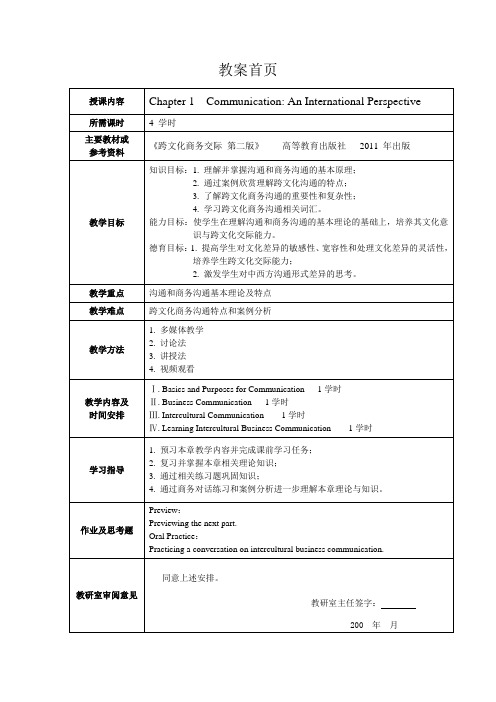
教案首页3. The Scope and Classification of Communication4. The Process of Communication1) A basic communication model consists of these components: the sender and receiver, the medium or channal, messages, noise, feedback, encoding and decoding.e.g. “That’s all for today. See you all next week.”I(sender) put into words(encoding) my meani ngs that “class is over”(messge) and speak the words(channel) in the hope that the words will be suitably understood(decoding) by the students(receiver).2) Models of Communication① Linear ModelAristotle --- speaker→speach→audience→effectOccasionLasswell --- 5-W modelWho say what in what channal to whom with what effect.② Contextualized ModelContext: the idea that every act of communication must happen in some sort of surroundings and what is meant by this is actually quite complicated. There is physical context, social context and cultural context.II. Business Communication1. Defining Business CommunicationBusiness communication is the exchange of oral, nonverbal, and written messages within (and across the boundaries of) a system of interrelated and interdependent people working to accomplish common tasks and goals.2. Internal and External Communication(1) Internal communication refers to the communication taking place within a given organization through such written or oral channels as memos, reports, proposals, meetings, oral presentations, speeches, and person-to-person and telephone conversationsInternal communication includes: downward/ upward/ horizontal communication.(2) External communication refers to the communication between the organization and the outside institutions and people---the general public, customers, vendors and other businesses, and government officials.3. Formal and Informal Communication(1) Formal communication which refers to such communicative activities as business letter, speech, talk, a product presentation and so on.(2) Informal communication, also called grapevine, exists in almost all organizations and at all levels. It has a small number of activists guiding and influencing the informal communication.Assignment:1. Preview Part 3.2. Review the terms and key points in this part.教案首页Warm-up ActivitiesLook at some pictures and try to identify what cultural differences are displayed. Left: Westerners Right: Chinesea. b.c. d.e. f.g. h.I. The Nature of Culture1. Definitions of Culture(1) Scholars give various definitions of culture from different perspectives. “Culture is the arts and other manifestation of human intellectual achievement regarded collectively.”-----Concise oxford Dictionary(2) Culture may be classified by three large categories of elements:-- Artifact (which include items ranging from arrowheads to hydrogen bombs, magic charms to electric lights, and chariots to jet planes)-- Concepts (which include such beliefs or value systems as right or wrong, God and man, ethnic, and the general meaning of life)-- Behavior (which refers to the actual practice of concepts or beliefs)(3) At the most rudimentary, culture consists of two levels: a level of values, or an invisible level and a visible level of resultant behavior or artifacts of some form.3. Characteristics of Culture•C ulture influences biological processes:e.g. Sneezing; food culture; sleeping ; giving birth•C ulture is transmitted from generation to generation:‐For cultures to exist and endure, they must ensure that their crucial messages and elements are passed on (through communication).‐Some of the behaviors a culture selects to pass on are universal and others are unique.‐Each individual is heir to a massive “library” of cultural information collected.•C ulture is selected:‐Each culture represents a limited choice of behavior patterns from the infinite patterns of human experience.‐What a culture selects to tell each succeeding generation is a reflection of what that culture deems important.‐The notion of selectivity suggests that cultures tend to separate one group from anther.•C ulture is ethnocentric:‐Ethnocentrism is a universal tendency for any people to put its own culture and society in a central position of priority and worth.‐It leads to a subjective evaluation of how another culture conducts its daily business.•C ultures are interrelated wholes:‐Cultures are coherent and logical systems.‐You touch a culture in one place and everything else is affected. –Hall (1977)•C ulture is subject to change:‐History abounds with examples of how cultures have changed because of laws, shifts in values, natural disasters, wars , etc.‐Technology promoted cultural change. (e.g. e-mail)‐Although cultures change, most change affects only the surface structure of the culture. The deep structure resists major alterations.•C ulture is like an iceberg:‐a greater part of culture is hidden under the water, such as views, attitudes, preference, love and hatred, customs and habits. They are out of our awareness, which makes the study of culture difficult. In order to trulyunderstand a culture, we must explore the behaviors below the waterline.•C ulture is like an onion:‐The skins of an onion - symbols that represent the most superficial and the easiest to perceive by an outsider and the least important to an insider.‐The second skin of the onion is heroes-the kind of people you worship.‐The third skin is rituals-collective activities that are considered socially essential within a culture.‐The core of culture-values, which are the deepest manifestation of culture and the most difficult to understand by an outsider.II. The Basics of Cultural Values1. Definition of Value(1) Oxford Dictionary: one’s principles or standards or one’s judgment of what is valuable or important in life.(2) Hofstede: values are a broad tendency to prefer certain states of affairs over others.(3) Kluckhohn: values are a conception, explicit or implicit, distinctive of an individual or characteristic of a group, of the desirable which influences the selection from available modes, means, and ends of action.2. Priorities of Cultural Values(1) Values can be divided into three types:•U niversal valuesUniversal values are values common to all people.e.g. a desire to live a happy life is a universal value, as everyone wants to live happily•C ultural-specific values•P eculiar expression or deviation of individuals within culture.These are aspects of subjective culture. So we say, although each of us has a unique set of individual values, there also are values that tend to permeate a culture. These are called cultural values. Therefore, values tend 10 bebroad-based, enduring, and relatively stable.(2) Priorities of ValuesValues can be classified as primary, secondary, and tertiary.What do you value most? How do your priorities influence your day-to-day activities, especially those relating to your business work'' Begin answering these questions by choosing from the following 20 values that are common to most international cultures, but their importance varies from culture to culture; (1) group harmony, (2) competition. (3) seniority, (4) cooperation, (5) privacy, (6)教案首页Warm-up ActivitiesLook at some pictures and try to identify what cultural differences are displayed. Left: Westerners Right: Chinesea. b.c. d.e. f.g. h.I. The Nature of Culture1. Definitions of Culture(1) Scholars give various definitions of culture from different perspectives. “Culture is the arts and other manifestation of human intellectual achievement regarded collectively.”-----Concise oxford Dictionary(2) Culture may be classified by three large categories of elements:-- Artifact (which include items ranging from arrowheads to hydrogen bombs, magic charms to electric lights, and chariots to jet planes)-- Concepts (which include such beliefs or value systems as right or wrong, God and man, ethnic, and the general meaning of life)-- Behavior (which refers to the actual practice of concepts or beliefs)(3) At the most rudimentary, culture consists of two levels: a level of values, or an invisible level and a visible level of resultant behavior or artifacts of some form.3. Characteristics of Culture•C ulture influences biological processes:e.g. Sneezing; food culture; sleeping ; giving birth•C ulture is transmitted from generation to generation:‐For cultures to exist and endure, they must ensure that their crucial messages and elements are passed on (through communication).‐Some of the behaviors a culture selects to pass on are universal and others are unique.‐Each individual is heir to a massive “library” of cultural information collected.•C ulture is selected:‐Each culture represents a limited choice of behavior patterns from the infinite patterns of human experience.‐What a culture selects to tell each succeeding generation is a reflection of what that culture deems important.‐The notion of selectivity suggests that cultures tend to separate one group from anther.•C ulture is ethnocentric:‐Ethnocentrism is a universal tendency for any people to put its own culture and society in a central position of priority and worth.‐It leads to a subjective evaluation of how another culture conducts its daily business.•C ultures are interrelated wholes:‐Cultures are coherent and logical systems.‐You touch a culture in one place and everything else is affected. –Hall (1977)•C ulture is subject to change:‐History abounds with examples of how cultures have changed because of laws, shifts in values, natural disasters, wars , etc.‐Technology promoted cultural change. (e.g. e-mail)‐Although cultures change, most change affects only the surface structure of the culture. The deep structure resists major alterations.•C ulture is like an iceberg:‐a greater part of culture is hidden under the water, such as views, attitudes, preference, love and hatred, customs and habits. They are out of our awareness, which makes the study of culture difficult. In order to trulyunderstand a culture, we must explore the behaviors below the waterline.•C ulture is like an onion:‐The skins of an onion - symbols that represent the most superficial and the easiest to perceive by an outsider and the least important to an insider.‐The second skin of the onion is heroes-the kind of people you worship.‐The third skin is rituals-collective activities that are considered socially essential within a culture.‐The core of culture-values, which are the deepest manifestation of culture and the most difficult to understand by an outsider.II. The Basics of Cultural Values1. Definition of Value(1) Oxford Dictionary: one’s principles or standards or one’s judgment of what is valuable or important in life.(2) Hofstede: values are a broad tendency to prefer certain states of affairs over others.(3) Kluckhohn: values are a conception, explicit or implicit, distinctive of an individual or characteristic of a group, of the desirable which influences the selection from available modes, means, and ends of action.2. Priorities of Cultural Values(1) Values can be divided into three types:•U niversal valuesUniversal values are values common to all people.e.g. a desire to live a happy life is a universal value, as everyone wants to live happily•C ultural-specific values•P eculiar expression or deviation of individuals within culture.These are aspects of subjective culture. So we say, although each of us has a unique set of individual values, there also are values that tend to permeate a culture. These are called cultural values. Therefore, values tend 10 bebroad-based, enduring, and relatively stable.(2) Priorities of ValuesValues can be classified as primary, secondary, and tertiary.What do you value most? How do your priorities influence your day-to-day activities, especially those relating to your business work'' Begin answering these questions by choosing from the following 20 values that are common to most international cultures, but their importance varies from culture to culture; (1) group harmony, (2) competition. (3) seniority, (4) cooperation, (5) privacy, (6)教案首页Warm-up ActivitiesLook at some pictures and try to identify what cultural differences are displayed. Left: Westerners Right: Chinesea. b.c. d.e. f.g. h.I. The Nature of Culture1. Definitions of Culture(1) Scholars give various definitions of culture from different perspectives. “Culture is the arts and other manifestation of human intellectual achievement regarded collectively.”-----Concise oxford Dictionary(2) Culture may be classified by three large categories of elements:-- Artifact (which include items ranging from arrowheads to hydrogen bombs, magic charms to electric lights, and chariots to jet planes)-- Concepts (which include such beliefs or value systems as right or wrong, God and man, ethnic, and the general meaning of life)-- Behavior (which refers to the actual practice of concepts or beliefs)(3) At the most rudimentary, culture consists of two levels: a level of values, or an invisible level and a visible level of resultant behavior or artifacts of some form.3. Characteristics of Culture•C ulture influences biological processes:e.g. Sneezing; food culture; sleeping ; giving birth•C ulture is transmitted from generation to generation:‐For cultures to exist and endure, they must ensure that their crucial messages and elements are passed on (through communication).‐Some of the behaviors a culture selects to pass on are universal and others are unique.‐Each individual is heir to a massive “library” of cultural information collected.•C ulture is selected:‐Each culture represents a limited choice of behavior patterns from the infinite patterns of human experience.‐What a culture selects to tell each succeeding generation is a reflection of what that culture deems important.‐The notion of selectivity suggests that cultures tend to separate one group from anther.•C ulture is ethnocentric:‐Ethnocentrism is a universal tendency for any people to put its own culture and society in a central position of priority and worth.‐It leads to a subjective evaluation of how another culture conducts its daily business.•C ultures are interrelated wholes:‐Cultures are coherent and logical systems.‐You touch a culture in one place and everything else is affected. –Hall (1977)•C ulture is subject to change:‐History abounds with examples of how cultures have changed because of laws, shifts in values, natural disasters, wars , etc.‐Technology promoted cultural change. (e.g. e-mail)‐Although cultures change, most change affects only the surface structure of the culture. The deep structure resists major alterations.•C ulture is like an iceberg:‐a greater part of culture is hidden under the water, such as views, attitudes, preference, love and hatred, customs and habits. They are out of our awareness, which makes the study of culture difficult. In order to trulyunderstand a culture, we must explore the behaviors below the waterline.•C ulture is like an onion:‐The skins of an onion - symbols that represent the most superficial and the easiest to perceive by an outsider and the least important to an insider.‐The second skin of the onion is heroes-the kind of people you worship.‐The third skin is rituals-collective activities that are considered socially essential within a culture.‐The core of culture-values, which are the deepest manifestation of culture and the most difficult to understand by an outsider.II. The Basics of Cultural Values1. Definition of Value(1) Oxford Dictionary: one’s principles or standards or one’s judgment of what is valuable or important in life.(2) Hofstede: values are a broad tendency to prefer certain states of affairs over others.(3) Kluckhohn: values are a conception, explicit or implicit, distinctive of an individual or characteristic of a group, of the desirable which influences the selection from available modes, means, and ends of action.2. Priorities of Cultural Values(1) Values can be divided into three types:•U niversal valuesUniversal values are values common to all people.e.g. a desire to live a happy life is a universal value, as everyone wants to live happily•C ultural-specific values•P eculiar expression or deviation of individuals within culture.These are aspects of subjective culture. So we say, although each of us has a unique set of individual values, there also are values that tend to permeate a culture. These are called cultural values. Therefore, values tend 10 bebroad-based, enduring, and relatively stable.(2) Priorities of ValuesValues can be classified as primary, secondary, and tertiary.What do you value most? How do your priorities influence your day-to-day activities, especially those relating to your business work'' Begin answering these questions by choosing from the following 20 values that are common to most international cultures, but their importance varies from culture to culture; (1) group harmony, (2) competition. (3) seniority, (4) cooperation, (5) privacy, (6)。
《商务跨文化交际》课件

了解和适应其他文化的工作 方式和商务惯例,可以提高 工作效率和成功实现商业目 标的几率。
文化差异的影响
文化差异在商务跨文化交际中起着重要的作用,涉及沟通方式、职业素养和社交礼仪。
1
职业素养
2
不同文化对职业素养的要求和期望有所不同,
如着装、礼仪和商务谈判的方式。
3
沟通方式
不同文化对沟通方式的看法和偏好可能存在 差异,需注意语言、非语言和书面沟通的差 异。
常见场景
跨国企业的日常办公、国际贸易谈判、合资企业的 运营等。
跨文化交际的意义
商务跨文化交际的重要性在于促进商业合作,打破文化障碍,并提高效率与成功率。
1 促进商务合作
2 打破文化障碍
3 提高效率与成功率
有效的跨文化交际可以建立 信任、加强合作,从而促进 商务关系发展。
帮助人们理解不同文化的价 值观、习俗和商业准则,从 而消除误解和冲突。
社交礼仪
在商务社交中,不同文化之间的社交礼仪也 存在差异,需要了解并尊重他们的文化准则。
跨文化交际的实践技巧
为了更好地进行跨文化交际,需要研究目标文化、意识自身文化差异,并提高跨文化交际能力。
研究目标文化
意识自身文化差异
提高跨文化交际能力
了解目标文化的价值观、习俗和商 务准则,以适应并尊重他们的文化。
商务跨文化交际
商务跨文化交际是在不同文化背景下进行商务交流和合作的过程。本课程将 探讨其定义、意义以及实践技巧,并通过成功案例对其进行解析。
什么是商务跨文化交际
商务跨文化交际是在全球化时代中,通过与不同文化背景的人进行沟通和合作,实现商业目标的过程。
定义
商务跨文化交际是跨越文化界限,以实现商业目标 的沟通和合作.
跨文化商务沟通ppt课件

1.跨文化商务沟通的客观障碍
(1)文化符号体系差异
(2)文化规范体系差异
(3)文化认知体系差异
2.跨文化商务沟通的主观障碍
(1)文化光环效应
(2)文化触角效应
跨文化商务沟通
26
第十章 跨文化商务沟通
二、关于跨文化商务沟通中障碍的对策分析
(一)南希•爱德勒的有关理论
为了取得跨国经营的更大成就, 目前西方 国家非常重视跨文化管理的研究, 并在实施中 取得了很好的效果。加拿大著名的跨文化组织 管理学者南希•爱德勒将企业在跨国经营中的 文化变革分为4个阶段, 并提出了各种管理措 施。
商务沟通与交流 电子教案
第十章
跨文化商务沟通
跨文化商务沟通
1
【本章要点】
跨文化与跨文化商务沟通的定义
跨文化商务沟通的模式与特点
跨文化商务沟通中的语言沟通与非语言 沟通
跨文化商务沟通中的障碍
跨文化商务沟通中的对策
跨文化商务沟通
2
第一节 跨文化商务沟通概述
第二节 跨文化商务沟通中的语言沟通 和非语言沟通
特点: 实行总部集权制,世界各地的子公司的 重要职务,一般留给母国人员担任。一般地说, 这种模式适合于无差异策略推广单一产品的特 大型跨国公司,他们的价值观念被普遍接受, 母国文化对其他文化有强大的吸引力。
跨文化商务沟通
10
第十章 跨文化商务沟通
(二)当地文化主导模式
跨国公司在建立海外子公司时,尽可能放 弃母国文化,而从当地文化背景出发构建适合 当地文化特点的子公司文化模式。一些东道国 股本占多数的合资企业,多采用这种模式。
跨文化商务沟通
7
第十章 跨文化商务沟通
(五)跨文化商务沟通
跨文化商务交际 Chapter 1 Culture, Communication and Cross

Culture Focus Case Study 1
This part helps you have a general idea about the cultural diversity in the workplace and communication in high- context culture and low- context culture. Cases are given for your further understanding. And then you are asked to finish the tasks.
Encounter Video Watching
Watch the video “ What Is Culture ” and complete the following tasks.
Encounter Video Watching
Task 1 Work in pairs, and discuss whether the following statements are true or false based on what you’ve
Chapter 1
Learning Objectives
On completion of this chapter you are able to: 1. understand what culture is and what elements culture includes; 2. have an understanding of your own culture; 3. get to know what cross-cultural communication is.
to the understanding of the world.
跨文化商务交际ChapterBusinessEtiquetteandSocialCustoms电子教案

In Europe, people hold the fork in the left hand and the knife in the right hand throughout the meal, a system that is generally agreed to be more efficient than the American zigzag method.
3. Dressing and dining 3.1 Dressing rules
What you wear, your hairstyle, the polish of your shoes and even the look of your fingernails
An expensive watch is usually noticed and is considered a subtle symbol of success and prosperity in just about every culture doing international business.
4. Social customs
Customs are behaviors
generally expected in specific situations and are established, socially acceptable ways of behaving in given circumstances. Customs vary not only by country but also by region or location within a country.
4.2 Invitation
- 1、下载文档前请自行甄别文档内容的完整性,平台不提供额外的编辑、内容补充、找答案等附加服务。
- 2、"仅部分预览"的文档,不可在线预览部分如存在完整性等问题,可反馈申请退款(可完整预览的文档不适用该条件!)。
- 3、如文档侵犯您的权益,请联系客服反馈,我们会尽快为您处理(人工客服工作时间:9:00-18:30)。
4. In 1970: ICC was recognized as an independent area of study by the International Communication Association (国际传播学会) 5. In 1972: The first international conference on intercultural communication was held in Japan. 6. In 1983 : Gudykunst ,American well known scholar in ICC, edited the first text on intercultural communication theory, Intercultural
• The focus of this course lies on Intercultural communication (IC)
Course Overview
• Seminar organization • Assessment: • 1)Attendance and participation.
• 3 contact hour per week (lecture) • 6 additional hours per week:
- course book - “fieldwork” (in preparation for presentation)
Requirement
1.Preview the text :Looking up the new words and expressions before class. 2.Take an active part in class discussions and performances. 3. Choose and read two recommended textbooks on intercultural communication – at least one in English. Books Recommended: [1] Ron Scollon, Suzanne Wong Scollon : Intercultural Communication: A Discourse Approach, 外语教学与研究出版社,2000 [2] 贾玉新:《跨文化交际学》,上海外语教育出版社,1997 [3] 林大津:《跨文化交际研究》,福建人民出版社, 1996 [4] 胡文仲:《文化与交际》,外语教学与研究出版社,1997
Communication Theories.
7. In the 1990s Theory construction and testing continues.
The nature of the study of ICC:
Interdisciplinary:
1. Linguists : Edward Sapir and Benjamin Whorf and their hypothesis :the Edward Sapir-Whorf hypothesis(萨丕尔 沃尔夫假设 ) 2. Anthropologists Edward Hall and his works: The Silent Language 3. Psychologists : Gordon Allport and his classic study, The Nature of prejudice
Break the ice!
• Quick class survey
• Speed dating/the story of your name
Welcome!
• The objectives of this course are for you:
• • • •
To acquire knowledge related to ICC (terminologies and definitions) ; To develop skills that will increase your intercultural communication competence; To understand how communication processes differ among cultures; To cultivate the ability to study and explore the issues concerning intercultural communication .
2)Project presentation and handout (the required essay ). 3)Essay.
• • Subject course book • 窦卫霖:《跨文化商务交际》,高等教育出版社,2011年
Time commitment
•Contact hours: 36 class period total •time commitment / 9 hours per week:
Getting started: Find your other half
With the person next to you, discuss the following:
•1) Introduce yourself •2)Were you involved in intercultural communication? •3) If you were, what difficulties you met during the
communication?
A brief introducthe study of ICC
The Development of the Discipline 1.In 1946 : The US government passed the Foreign Service Act and established the Foreign Service Institute. The institute hired Edward T. Hall… 2.In 1959 : The publication of the Silent Language by the American cultural anthropologist, Edward T.Hall marked the emergence of ICC. 3.In 1966: ICC was regarded as curriculum in the US.
Intercultural Communication
Lecturer:李仪(Maggie) Email: lyzjyl@
My story
Graduated from University of Melbourne Worked for AMES(Australian Migration English Service) Was an IELTS & TOFEL teacher
